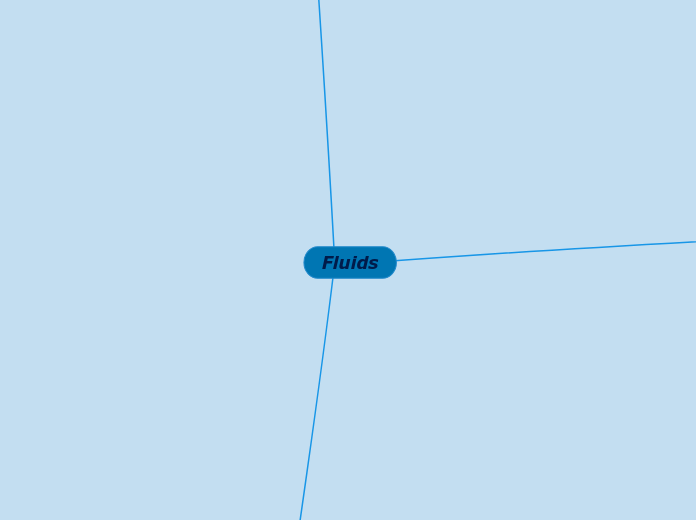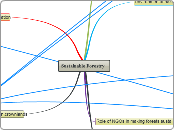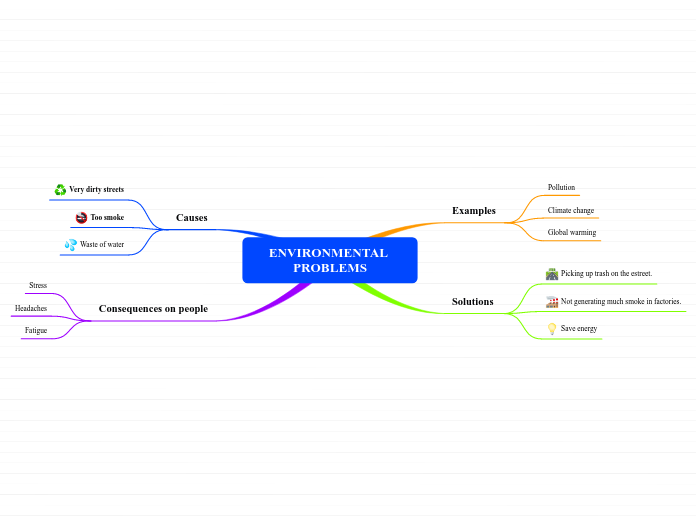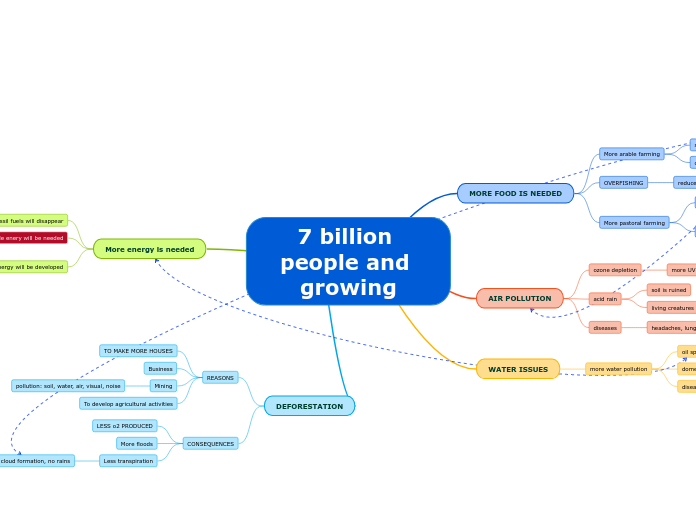International Carbon Action Partnership
Contribute to global efforts to create a global carbon market
GHG mitigation
Bring together countries, city's, and provinces
Focus on emissions trading
Initiatives
International initiatives
Renewable energy
Less power plants
less pollutants in atmosphere
arsenic, beryllium, cadmium, chromium, & nickel
One child
Use less harmful chemical such as halocarbons
Walking and biking
Solar energy
Eating less meat
Reforestation
Paris Agreement
Goals
Saving and increasing forests
Fifty-five countries, or enough to bring the total global emissions to 55%, were needed before the agreement could come into effect
To date, 97 have joined, representing 69.22% of global emissions
Developed countries take a lead in reducing greenhouse gas emissions
Review every 5 years
developed countries must provide money to developing countries
Update and enhance technologies
New technologies
aim for greenhouse gas emissions to peak as soon as possible
developed countries must continue to take a lead for 3rd world and 2nd world countires
Rich countries must provide 100 billion dollars from 2020 as a floor
Must be payed by 2025
keep global temperatures well below 2 degrees Celsius
Global Environment Facility
Focus areas
ozone depletion
international waters
biodiversity,
climate change,
Kyoto Protocol
expand business opportunities
Sustainable businesses
The international community agreed for the first time on binding targets and measures for combating climate change
First commitment period
5 per cent emission reduction compared to 1990 levels over the five year period 2008–2012
2nd commitment period
Limit emmisoins in atmosphere
based on trades
starting in 2013 and lasting until 2020
binding emission reduction targets for 37 industrialized countries and economies in transition and the European Union
binds developed countries
Most GHG released into the atmosphere
Heavier burden on developed countries
committing industrialized countries and economies in transition to limit and reduce greenhouse gases (GHG) emissions in accordance with agreed individual targets
United Nations Framework Convention on Climate Change
Allow ecosystems to adapt to climate change
ensure that food production is not threatened and unable economic development to proceed in a sustainable manner
International environmental society
197 parties
March 21 1994
prevent dangerous anthropogenic (human induced) interference with the climate system
stabilize greenhouse gas concentrations
Earth's Dynamic Climate
Impacts
Global impact
environmental impact
Our wildlife
Wetland systems
biodiversity loss
tropical forests
Mediterranean
savanas
conifer forests
Stress on ecological systems
Harvesting
Pollution
land degradation
Land conversion
Land species move to higher elevations
Migration up north
Our oceans
Coral reefs
less due to higher CO2 levels
Oxygen depletion
Adverse affects on ocean life
less oxygen
More CO2 in oceans
Less food for fish
Affect on food chain
Energy for hurricanes and cyclones
Less cold deepwater circulation
Ocean deoxygenation
Shift in species distribution
Marine heatwaves
ocean acidification
large scale change sin ocean circulation
increased temperature stratification
rising sea levels
thermal expansion
Cyrosphere
Threat to alpine glaciers
Thickness of sea ice has decreased by 66%
Sensitive to changes in global climate
Extreme weather events
Heatwaves
Increases wildfires
high humidity
Anthropogenic greenhouse gas affect
Storms
Droughts
Overpopulation
urban expansion
increased water demand
More hurricanes
Increased intensity
More level 4 and 5 hurricanes
Changes in precipitation patterns
Most of the world will have a 16–24% increase in heavy precipitation by 2100
Wetter globally
Reduction in rainfall in subtropics
Change in water quality
Crop damage
Peak precipitation is increasing between 5 and 10% for every one degree Celsius increase
Landslides
Loss of crops and livestock
Damage infrastructure
Intense droughts and heat waves
Impact farmers
Loss of crops
More dust storms
Insect deitasses
Shortage of drinking water
Accelerated sea level rise
storm surges and high tides may combine resulting in more damage
Cause trillions of dollars of damage throughout world
Trees are flowering sooner
Change ecosystems
Animals come out of hibernation sooner
Frost free seasons lengthen
Glaciers shrink and fall off
Oceans absorb more heat
Damages coral reefs
Less marine life
Less protection against floods
economic impact
Agricultural industry will suffer
Drought
Water insecurity
Food insecurity
Shortage of food
Marine based economies suffer
Over seafood in general
Less shellfish
fish populations will go down
less breeding grounds
Greater risks to different buildings
Increased coastal and river flooding
Infrastructure
business
Homes
Social impacts
People near coastlines
Water security
Food security
Vulnerable groups
Africa
Water
Food scarcity
Environnemental migration
energy
timber
Food
Indigenous populations
Farmers
Impact on Canadian climate
Insects and disease
Mosquitos
Less clean water as floods disrupt cleavage system
Many will die
Increase due to high levels of precipitation
Loss of ice and snow
Permafrost may melt
Lots of methane
Rising sea levels
Shrinking land areas
Eroding costlines
Less positive albedo feedback
Over 20% of ice has disappeared since 1970
Increases in forest fires
Canada has 9% of the world's forests
38% of landmass is covered with forests
Increase greenhouse gas emissions in atmosphere
Billions of dollars in damage
More money gone to waste
High winds
Lightning strikes
Dry conditions
More severe forest fires
Extreme temperatures
over 719 deaths in Lyton, British Columbia
Extreme weather throughout the prairies
Negative impacts
Famous events
2013 Alberta floods
Fossil fuel industry
Increased its greenhouse gas emissions by 21.6% since 1990
Impact on society
Many Inuit populations will suffer
Live in Nunavut
Live in Yukon
Live in Northwest Territories
Live near shores
Climate
Gulf Stream may collapse next coming decades
Gulf Stream has a huge impact of Canadian weather
Rain and weather patterns may shift
Potential increase in hurricanes
Infrastructure loss
Money loss
Farmers crops
Huge impact on economy
Food industry would be down
less quantity
less quality
Sea levels would rise
Present Biomes
Desert
Grassland
Temperate rainforest
Temperate deciduous forest
Boreal forest
Tundra
Permanent ice
Direct impacts
Hotter and wetter
Increase of temperature of 1.7 degrees celsius since 1948
Sea level rise
Warmer waters
Increased positive feedback loop
Increased precipitation
Continued warming of high latitudes
Contributing Factors
Feedback
Influence albedo
Sea ice
Ice sheets
greenhouse gases
Ocean temp
Terrestrial vegetation
Important
Predict future
Volcanic activity
Release sulphur dioxide into stratosphere
Particles reflect sunlight
Good
Human acitivities
Manufactured chemicals
Depletion stratospheric and tropospheric ozone
Halocarbons
Montreal protocol
CFC's are released into the environment
Causes damage to human nervous system, kidney's, and the liver
Sunlight breaks CFC's up releasing chlorine
Chlorine reacts with ozone, and destroys it
More reactions cause more depletion of ozone
Ground-level ozone,
produced by a reaction
between sunlight and
chemicals in vehicle exhaust,
occurs near ground level as a
smog-forming pollutant
Decreased plant growth
Phytoplankton and zooplankton very sensitive and die
Damage animal cells
I
All marine life is affected (butterfly affect of food chain)
cause various types of cancers
ageing of skin
damage to skin cells
Chemical reactions happen which break down ozone particles
Fossil fuels
Excess nitrogen in atmosphere
creation of smog
can cause asthma
Narrow airways
Damage plant cells and inhibit growth
Worsen existing heart and lung problems or perhaps cause lung cancer
irritate your eyes, nose and throat
Ocean acidification
Air pollution
Emissions
Water pollution
Land degradation
Flooding
Descertification
Decline of quality of life of people
Less trees
Increase greenhouse gas emissions
Soil erosion
Threatens water systems
Acidic oceans
Increase of pH
Trophic cascade
Toppling entire ecosystems
Power plants
emit arsenic, beryllium, cadmium, chromium, & nickel
neurological problems
air pollution
asthma, cancer, heart and lung ailments
Overfishing
Impact the economy
Change food chain
change reproduction rates
Oil drilling
Poor water quality
Groundwater contamination
clearing an area of vegetation
Habitat loss
Disturb land and marine ecosystems
Transport and vehicals
Use complete combustion of hydrogen and carbon
Each oxygen atom connects up with two hydrogen atoms to form water.
Oxygen
Latitude
More sun
6CO2 + 6H2O → C6H12O6 + 6O2 + 6H2O
Synthesis reaction
Balanced chemical equation of photosynthesis
Plants produce glucose and oxygen from carbon dioxide and water in the presence of sunlight.
Temperatures drop the further an area is from the equator
Due to the curvature of the earth
More energy is lost
Temperatures are cooler
Weather
Clouds
Precipitation
More wildfires
More droughts
More floods
Wind
Temperature
Increased temperatures
Habitat destruction
Increased drought
Less plants
Animals wake from hibernation sooner
Migration happens at different times
Plants grow/bloom earlier
Survive longer in fall
Less ice
Less ice albedo feedback
Oceans exposed
Increase in absorbed sunlight
Thermal expansion
Impact on food chain
Longer heat waves
Body becomes warmer
Blood vessels open up
Lower blood pressure
Heart works harder to push blood throughout body
Blood may clot
Heart attack may occur
Sweating
Swollen feet
Heat rash
More heat waves
Negative health affects
Overconsumption
Increased air pollution
Acid rain
PH of rain falls between 2 and 5.5
Natural water systems acidic
Increased climate breakdown
Reduced ecosystem health
decreased biodiversity
Less production ecosystem
Enviormental degradation
Animal extinction
Desertification
Biodiversity loss
Deforestation
Erosion
Ecological overshoot
Reduction in earth's carrying capacity
Food production
Global warming leads to better agriculture yields
Fertilizers
Pollution of air
Respiration
Respiratory system and circulatory system work together
Happens in plants/animals cells
energy is released from glucose
As waste products, carbon dioxide and water
All the other chemical processes needed for life can happen
Lungs expand and compress
Diaphragm relaxes
Breath in oxygen breath out carbon dioxide
Disturbance of respiration due to air pollution
Negative impact on human health
Pollution of soil
Negative impact on plants
Pollution of water
Negative impact on marine life
Food chain is disturbed
Lots of energy used
Greenhouse gas effect
Greenhouse gases keep our planet livable by holding onto some of Earth's heat energy so that it doesn't all escape into space
Traps radiation from the sun and warms the planet's surface
Sustain life on earth
a warming of Earth's surface and troposphere
Anthropogenic
water vapour
Methane
Decomposing garbage
Termites and cattle
Rice paddies
Wetlands
CH4 (g) + 2O2 (g) → CO2 (g) + 2H2O (g).
Incomplete combustion
Carbon dioxide
2CO + O2 → 2CO2
Exothermic
Combustion reaction
hydrocarbon reacting with Oxygen gas.
Elevation
Warmer in winter than places inland at the same latitude and altitude
This means that coastal locations tend to be cooler in summer
Locations at a higher altitude have colder temperatures.
Wind and air masses
a change in wind results in a change of weather
Hot and cold air
Winds move air masses,
They carry their weather conditions from the source region to a new region
Air masses reach new region
Might clash with another air mass
That has a different temperature and humidity
Ocean currents
Local heat transfer and precipitation
Winds blowing over warm currents result in a good amount of rainfall
Moisture laden
Cold currents drop the temperature along the coast
Due to global warming fewer winter deaths
Warm currents raise the temperature along the coast
clashing air temperatures
formation of clouds, fog, and cause precipitation
water vapour increases temperature & humidity of the air
Water vapour interaction with CO2
Higher level of water vapour
Reduced albedo
More water evaporating from oceans
precipitation and storms
act as conveyer belt
Warm and cold water
helping tropical areas cool off
sending heat towards polar regions









